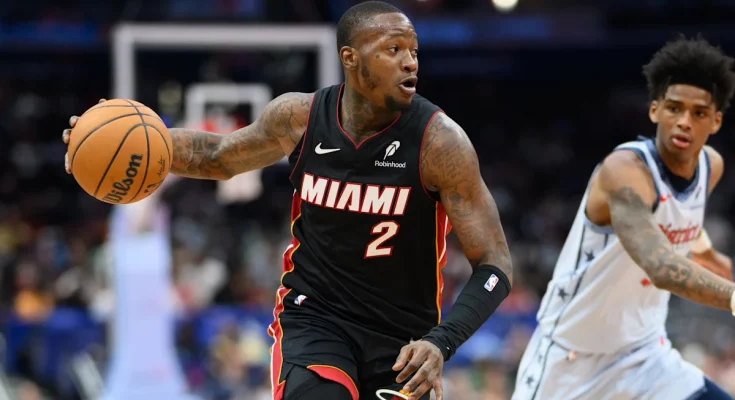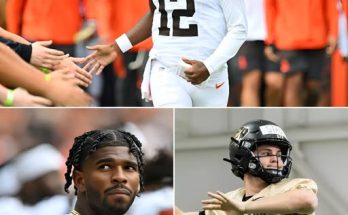There was a time when Tyler Herro was simply seen as the talented scorer who burst onto the national scene during the Miami Heat’s 2020 NBA Finals run, an electric shot-maker with a flair for the dramatic and the confidence of a seasoned veteran. But for years after that Cinderella bubble stretch, Herro’s narrative grew cloudy. He was inconsistent. He was injured. He was in trade rumors. He was often painted as the expendable asset in a championship-hungry organization, particularly as the Heat relentlessly pursued superstars like Damian Lillard, Kevin Durant, and Donovan Mitchell. But fast forward to the 2025 offseason, and something remarkable has happened: Tyler Herro has shattered expectations, and is now emerging as a legitimate leader for the Miami Heat. In the post-Jimmy Butler evolution of the team’s culture and style, it’s Herro—not Bam Adebayo, not a high-priced free agent, not a rookie sensation—who is suddenly defining the Heat’s identity. And perhaps most importantly, it is the pick-and-roll combination of Herro and rookie point guard Jared Ware that may end up salvaging what looked like a stagnating offensive system in Miami.
To understand the magnitude of Herro’s rise, it’s important to first understand where he’s come from. Drafted 13th overall in 2019, Herro entered the league with something to prove. Critics called him undersized, one-dimensional, too flashy. But almost immediately, he showed he belonged, posting 16.0 points per game as a rookie and becoming a key contributor in Miami’s Finals appearance. That early burst of stardom, though, brought with it a new pressure. Herro was expected to level up quickly—to become an All-Star, to become reliable, to carry his weight in a system that prized toughness and consistency.
The subsequent seasons were a mixed bag. He won Sixth Man of the Year in 2022, but still faced skepticism. Injuries limited his availability. His defense was often targeted. And while his scoring punch was undeniable, many wondered if he could truly lead a team, or if he was simply a bench scorer masquerading as a foundational piece. The turning point came in the 2024-25 season, where Miami’s offensive engine sputtered, and the need for fresh direction became obvious. Jimmy Butler’s age and health were becoming questions. Kyle Lowry had long been moved. Bam Adebayo continued to anchor the defense, but offensively, the Heat were stuck in molasses. And with each passing game, it became clearer that the torch wasn’t being passed to Herro—it was already in his hands.
By the midpoint of the 2025 season, Herro had made the leap that many fans had long waited for. His scoring efficiency rose across the board, but more importantly, his playmaking took a quantum step forward. No longer was he just an elite tough-shot maker—he was reading the floor, dissecting coverages, and manipulating defenders like a true lead guard. His assists climbed to a career-high 6.8 per game. His usage rate increased, and yet his turnover percentage dropped. But perhaps most surprisingly, his leadership emerged as the loudest signal of all.
On a team lacking vocal alpha energy, Herro stepped up—holding teammates accountable, setting the tone in practices, and committing himself to the finer points of the game. Gone was the young gun trying to go viral with every dribble; in his place stood a poised, measured player who understood timing, spacing, and rhythm. It’s easy to forget that Herro is still only 25. Yet he’s now entering that sweet spot in a player’s career, where physical talent intersects with experience and strategic maturity.
The biggest reason for Miami’s newfound offensive pulse, though, isn’t Herro alone. It’s his connection with Jared Ware, the Heat’s surprise breakout rookie point guard drafted in the late first round out of Houston. Ware came into the league with a reputation as a gritty two-way guard with high basketball IQ, but few expected him to become a pivotal piece so quickly. From the moment Ware was inserted into the starting lineup, the synergy with Herro was undeniable. Together, they formed one of the most promising pick-and-roll combinations in the Eastern Conference.
The Herro-Ware PnR—or pick-and-roll—has become a tactical lifeline for Erik Spoelstra’s offense. With Herro handling the ball and Ware acting as both screener and secondary initiator, the Heat have found a way to blend speed, vision, and shooting into one seamless action. What’s particularly striking is how the Heat have flipped the traditional dynamic. Instead of the guard using a big man screen and attacking downhill, Miami often has Ware set flat or angled screens for Herro in space, creating confusion for defenders who are unsure whether to switch, trap, or hedge. Ware’s own shooting threat forces defenses to stay honest, and Herro’s ability to either pull up from midrange, snake the dribble into the paint, or kick out to the perimeter has made this duo nearly unguardable in crunch time situations.
From a technical standpoint, Herro has mastered the art of tempo. He’s no longer rushing into his shots or forcing isolation plays. Instead, he manipulates defenders with hesitations, behind-the-back resets, and misdirection dribbles, often creating just enough separation to fire off his high-release jumper. Ware, for his part, reads the second line of defense incredibly well for a rookie. His ability to reposition himself, dive at the right angle, or pop out for a three makes him a rare multidimensional screen partner. In the past, Herro’s pick-and-roll numbers were average at best, mostly due to the lack of dynamic roll partners and spacing. Now, with Ware and a more floor-spread Heat offense, Herro is averaging 1.15 points per possession as the pick-and-roll ball handler—ranking in the top 15 league-wide.
There’s also a psychological element at play. Herro and Ware genuinely trust each other. You can see it in the way they communicate, in their eye contact before possessions, in their willingness to defer in big moments. Herro knows that Ware won’t overplay his role, and Ware knows that Herro is now capable of setting up a play rather than just finishing it. That kind of chemistry is rare—especially between a young veteran and a first-year player. But in Miami’s culture, which prioritizes hard work, accountability, and system over ego, it’s the perfect storm.
What does this mean for the Heat moving forward? For starters, it gives them an offensive identity rooted in motion and decision-making rather than isolation. In the NBA’s current era—where heliocentric offenses are both popular and prone to stagnation—the Herro-Ware pick-and-roll gives Miami versatility. They can run it against drop coverage and get open pull-ups. They can attack switches and create mismatches. They can force rotations and hit corner shooters like Jaime Jaquez Jr. or Duncan Robinson. In short, it’s not just a go-to action—it’s a system engine.
Herro’s ascension also repositions the Heat in the broader Eastern Conference hierarchy. Teams like the Celtics and Bucks may still have more top-end talent, but Miami’s cohesion, tactical innovation, and balance give them a fighting chance in every series. Herro isn’t just carrying the scoring load—he’s influencing the pace, dictating spacing, and anchoring late-game possessions. For years, critics asked whether Herro could be a “1A” option. That question now feels outdated. He’s not just capable—he’s thriving in that role.
There’s an educational lesson in all of this, especially for fans and analysts who rush to label players too early in their careers. Herro’s path reminds us that development is nonlinear. That setbacks—whether through injury, role changes, or team turbulence—don’t always signal ceilings. Growth often comes in spurts. It can be internal, unseen in the box score. It can happen in the film room, in the weight room, in summer workouts with trainers and veteran mentors. And when it clicks, it clicks suddenly.
In Herro’s case, the click came from necessity and opportunity meeting preparation. With Miami needing a new voice, a new rhythm, and a new focus, Herro stepped into the vacuum not with noise, but with clarity. He improved where he was weakest—on defense, in playmaking, in poise under pressure. He turned his offensive strengths into weapons that lifted others, not just himself. And in doing so, he changed the story—not just of his career, but of Miami’s future.
The Heat organization, known for valuing “dogs” over divas, now has a new kind of star—one who’s earned everything the hard way. Herro may never be the face of a sneaker campaign or the subject of MVP chants. But if leadership is defined by accountability, adaptability, and impact, then Tyler Herro has arrived. And with Jared Ware by his side, Miami’s offense has a chance to evolve into one of the most unique, efficient units in the NBA.
As the league adapts to this new-look Heat, the challenge will be how to contain a system that doesn’t rely on a single action, but a philosophy of movement, intelligence, and trust. Herro’s transformation is proof that stars aren’t born fully formed—they are forged, season by season, challenge by challenge. And as the Herro-Ware pick-and-roll continues to grow in complexity and effectiveness, the rest of the league may need to reassess how they view both players—and the new threat emerging in South Beach.
If Miami can continue to build around this foundation, the implications are significant. Suddenly, they aren’t just clinging to playoff relevance—they’re building toward sustained competitiveness. It opens the door for Bam Adebayo to focus more on defensive mastery without overextending his offensive load. It allows Miami’s shooters to thrive in roles designed to amplify spacing. It gives Spoelstra the chess pieces he needs to counter whatever defensive looks opponents throw at them. And most importantly, it proves that belief in internal growth—when matched with the right culture—can sometimes trump the glitz of blockbuster trades.
Tyler Herro’s journey isn’t just about one player proving doubters wrong. It’s about how a franchise can evolve without sacrificing its values. It’s about how leadership can emerge from the most scrutinized corners. It’s about how the NBA, for all its constant movement, still rewards those who commit to the grind. And as the Herro-Ware duo continues to redefine expectations, one thing is now clear: the Miami Heat didn’t just survive without a superstar addition—they may have found one within.



